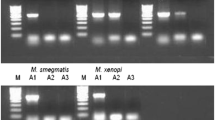Abstract
The family Chlamydiaceae contains nine species pathogenic to humans and animals, but their routine identification is hampered by inadequate detection methods. In an attempt to find a new region for PCR detection and discrimination of the Chlamydiaceae species, the 3′ end of the omp2 gene of Chlamydiaceae has been examined. Since sequence data for this part of the genes of Chlamydophila felis and Chlamydia suis had not been available, the near full length of the omp2 genes of these species were cloned and sequenced. Consensus primers enabling amplification of a previously untargeted region spanning 1,030 bp at the 3′ end of the gene were designed. Discrimination of all nine Chlamydiaceae species was achieved via RFLP analysis of the amplicons with RsaI and HinfI or RsaI and TaqI endonucleases or via electrophoretic mobility analysis of the RsaI restriction fragments in agarose gel with bisbenzimide-PEG. Intraspecies uniformity of the RFLP patterns was evaluated by the typing of reference strains, isolates of human and animal origin from culture collections, and clinical specimens, and by computer analysis of GenBank sequences. The 3′ end of the omp2 gene was shown to be an appropriate marker region suitable for rapid identification of Chlamydiaceae species and can be used for characterization of collection strains and new isolates in taxonomic, epidemiological, and clinical purposes.




Similar content being viewed by others
References
Anderson IE, Baxter SI, Dunbar S, Rae AG, Philips HL, Clarkson MJ, Herring AJ (1996) Analyses of the genomes of chlamydial isolates from ruminants and pigs support the adoption of the new species Chlamydia pecorum. Int J Syst Bacteriol 46:245–251
DeGraves FJ, Gao D, Kaltenboeck B (2003) High-sensitivity quantitative PCR platform. Biotechniques 34:106–115
Demkin VV, Edelstein MV, Zimin AL, Edelstein IA, Suvorov MM (2000) Detection of sequence variation in PCR-amplified fragments of omp2 gene from three species of the family Chlamydiaceae using agarose gel electrophoresis containing bisbenzimide-PEG. FEMS Microbiol Lett 184:215–218
Everett KD, Andersen AA (1997) The ribosomal intergenic spacer and domain I of the 23S rRNA gene are phylogenetic markers for Chlamydia spp. Int J Syst Bacteriol 47:461–473
Everett KD, Andersen AA (1999) Identification of nine species of the Chlamydiaceae using PCR-RFLP. Int J Syst Bacteriol 49:803–813
Everett KD, Bush RM, Andersen AA (1999) Emended description of the order Chlamydiales, proposal of Parachlamydiaceae fam. nov. and Simkaniaceae fam. nov., each containing one monotypic genus, revised taxonomy of the family Chlamydiaceae, including a new genus and five new species, and standards for the identification of organisms. Int J Syst Bacteriol 49:415–440
Hartley JC, Kaye S, Stevenson S, Bennett J, Ridgway G (2001) PCR detection and molecular identification of Chlamydiaceae species. J Clin Microbiol 39:3072–3079
Kaltenbock B, Schmeer N, Schneider R (1997) Evidence for numerous omp1 alleles of porcine Chlamydia trachomatis and novel chlamydial species obtained by PCR. J Clin Microbiol 35:1835–1841
Kristensen VN, Borresen-Dale AL (1997) Improved electrophoretic separation of polymorphic short tandem repeats in agarose gels using bis-benzimide. Biotechniques 23:634–636
Loeffelholz MJ, Lewinski CA, Silver SR, Purohit AP, Herman SA, Buonagurio DA, Dragon EA (1992) Detection of Chlamydia trachomatis in endocervical specimens by polymerase chain reaction. J Clin Microbiol 30:2847–2851
Muller M, Kruse L, Tabrett AM, Barbara DJ (1997) Detection of a single base exchange in PCR-amplified DNA fragments using agarose gel electrophoresis containing bisbenzimide-PEG. Nucleic Acids Res 25:5125–5126
Sachse K, Hotzel H (2003) Detection and differentiation of Chlamydiae by nested PCR. Methods Mol Biol 216:123–136
Schachter J, Stephens RS, Timms P, Kuo C, Bavoil PM, Birkelund S, Boman J, Caldwell H, Campbell LA, Chernesky M, Christiansen G, Clarke IN, Gaydos C, Grayston JT, Hackstadt T, Hsia R, Kaltenboeck B, Leinonnen M, Ocjius D, McClarty G, Orfila J, Peeling R, Puolakkainen M, Quinn TC, Rank RG, Raulston J, Ridgeway GL, Saikku P, Stamm WE, Taylor-Robinson DT, Wang SP, Wyrick PB (2001) Radical changes to chlamydial taxonomy are not necessary just yet. Int J Syst Evol Microbiol 51:249, 251–253
Sheehy N, Markey B, Gleeson M, Quinn PJ (1996) Differentiation of Chlamydia psittaci and C. pecorum strains by species-specific PCR. J Clin Microbiol 34:3175–3179
Watson MW, Lambden PR, Clarke IN (1991) Genetic diversity and identification of human infection by amplification of the chlamydial 60-kilodalton cysteine-rich outer membrane protein gene. J Clin Microbiol 29:1188–1193
Acknowledgements
We are indebted to Dr. K.D.E. Everett for providing us a panel of reference strains. We thank Dr. P. Saikku, Dr. S.S. Yamnikova, and Dr. M.V. Edelstein for chlamydial DNA, strains, or isolates, and Dr. M. S. Zimina for helpful advice on cloning.
Author information
Authors and Affiliations
Corresponding author
Rights and permissions
About this article
Cite this article
Demkin, V.V., Zimin, A.L. A new amplification target for PCR–RFLP detection and identification of Chlamydiaceae species. Arch Microbiol 183, 169–175 (2005). https://doi.org/10.1007/s00203-004-0757-2
Received:
Revised:
Accepted:
Published:
Issue Date:
DOI: https://doi.org/10.1007/s00203-004-0757-2




